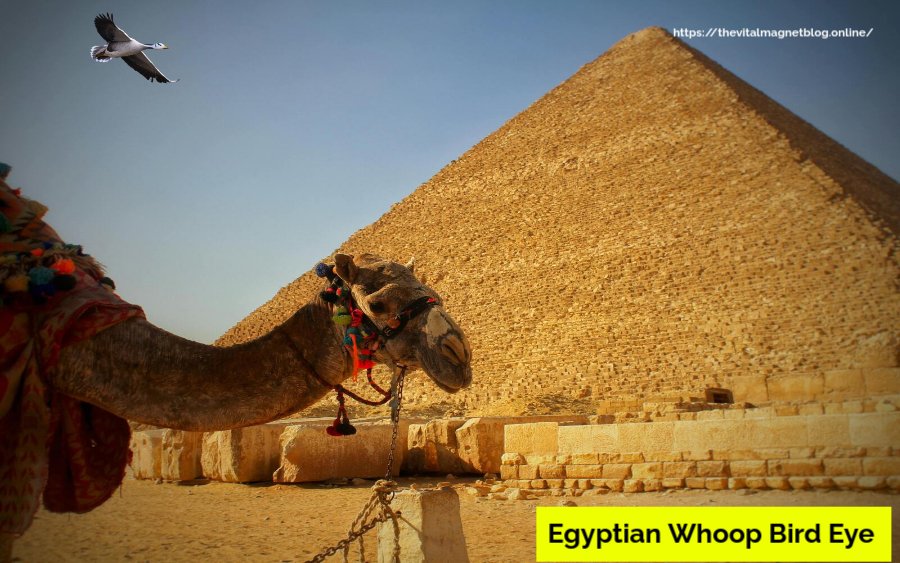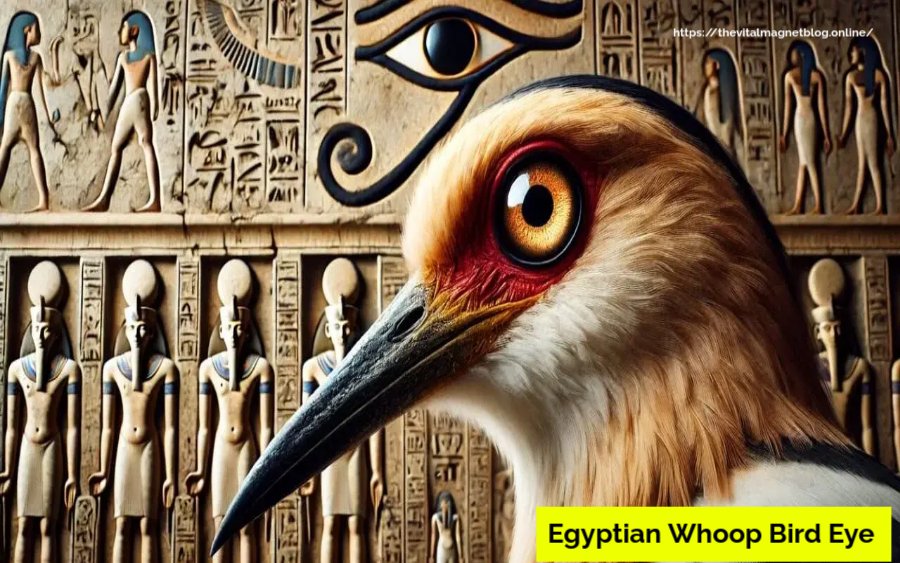The Egyptian whoop bird, or hoopoe, has always intrigued nature lovers and historians alike. With its striking appearance and unique behaviors, the hoopoe’s eye is often a subject of wonder. This bird, deeply tied to Egyptian culture, isn’t just known for its bright feathers and distinct crown but for its incredibly sharp and perceptive eyesight. In this article, we’ll take a journey into the fascinating world of the Egyptian whoop bird eye and uncover the secrets it holds.
Table of Contents
The Hoopoe: Egypt’s Sacred Feathered Friend
The hoopoe bird, commonly referred to in local dialects as the “whoop bird,” has long been revered in Egyptian history. Its vibrant feathers, distinctive crest, and iconic “whoop-whoop” sound have earned it a place in Egyptian folklore and mythology. However, what sets the hoopoe apart isn’t just its physical beauty but the incredible way it sees the world.
Hoopoes have been celebrated not only in Egyptian culture but across the world. In ancient texts, they’re depicted as messengers and sacred animals. Yet, their eye is a less talked about feature that deserves recognition. This bird’s ability to see things clearly from great distances is extraordinary, and understanding it can open doors to deeper appreciation of Egyptian wildlife.
Egyptian Whoop Bird Eye: A Natural Marvel
What makes the Egyptian whoop bird eye so unique? For starters, its sharpness is designed for both day and night vision, helping the hoopoe navigate Egypt’s varied landscapes—from desert dunes to lush gardens. Their eyes have specialized receptors that allow them to spot small insects from afar, making them master hunters in the bird kingdom.
The hoopoe’s keen eyesight is particularly useful when hunting for food. Their eyes pick up the slightest movements in the ground, and with swift precision, they swoop down to catch insects and worms that are barely visible to the human eye. Imagine walking through a field, and something as tiny as a beetle catches your attention—that’s how powerful the whoop bird’s eye truly is.
A Bird’s Eye for the Details: Adaptation in the Wild
The Egyptian whoop bird eye isn’t just about clarity; it’s a tool perfectly adapted to the bird’s environment. Egypt’s arid desert landscapes are filled with visual challenges—shimmering heat, glaring sunlight, and camouflaged prey. But the hoopoe’s eye can cut through these visual distractions, allowing the bird to thrive where other animals might struggle.

During the day, their vision helps them avoid predators while at night, they rely on their incredible night vision to continue their hunt for food. While some birds might struggle with the lack of light, the hoopoe’s eyes are well-equipped for low-light conditions. It’s truly remarkable how their eyesight has evolved over centuries to match Egypt’s harsh environment.
Symbolism of the Egyptian Whoop Bird Eye in Ancient Culture
Throughout history, the hoopoe has been a symbol of wisdom and protection in Egyptian culture. Its sharp eye has often been compared to that of the all-seeing gods, representing clarity and foresight. In ancient Egyptian mythology, the whoop bird was seen as a messenger of the gods, often bridging the human world with the divine.
This reverence for the bird’s eye can also be seen in the intricate carvings and artwork that adorn Egypt’s ancient temples. The bird’s presence in these sacred spaces speaks volumes about the admiration Egyptians held for the whoop bird’s eye and its significance as a spiritual symbol.
How the Hoopoe’s Eye Hunts with Precision
Hoopoes are known for their methodical hunting techniques, and their eyes play a crucial role in this. Their eyesight allows them to detect subtle movements on the ground, enabling them to zero in on prey that might go unnoticed by other creatures. The precision with which they spot and capture insects is astounding.
Their binocular vision allows them to see from multiple angles at once, giving them a distinct advantage when scanning the terrain. The Egyptian whoop bird eye is a testament to nature’s engineering, offering the bird a survival edge in its natural habitat.
The Science Behind the Egyptian Whoop Bird Eye
To fully appreciate the whoop bird’s eye, we need to look at the science behind it. Like many birds of prey, the hoopoe has a higher density of cone cells in its retina, which enhances its ability to detect color and movement. This is especially important in Egypt, where the sun’s intense glare can obscure details that most animals would miss.
The hoopoe’s eye functions similarly to a high-tech camera lens, with the ability to adjust to varying light conditions quickly. This adaptability ensures that whether it’s hunting during the bright daylight hours or at dusk, the Egyptian whoop bird eye performs exceptionally well in any situation.
The Hoopoe’s Eye in Literature and Art
The Egyptian whoop bird eye has captured the imagination of artists and poets for centuries. In ancient Egyptian hieroglyphics, the bird is often portrayed with exaggerated eyes, symbolizing its sharp vision and deep wisdom. More recently, writers have used the hoopoe as a metaphor for clarity of thought and perception, linking it to its keen eyesight.
Art throughout history has often depicted the hoopoe perched high above landscapes, gazing intently with its striking eyes—an image that conveys a sense of all-knowing observation. The fascination with the whoop bird’s eye continues to inspire modern artists and writers today.
Hoopoe’s Eye: Protecting Its Young and Territory
Beyond hunting, the Egyptian whoop bird eye serves another crucial function—protecting its young. Hoopoes are fiercely protective of their nests, and their sharp eyesight helps them keep a vigilant watch over their offspring. They can spot threats from great distances and act swiftly to defend their territory.
This bird’s watchful nature makes it an excellent protector, not just for its young but also for its surrounding environment. By keeping a close eye on their habitat, hoopoes help maintain balance in the ecosystem, ensuring that they, along with other species, continue to thrive.
The Evolutionary Tale of the Egyptian Whoop Bird Eye
Evolution has played a critical role in the development of the Egyptian whoop bird eye. Over millennia, the hoopoe has honed its vision to meet the demands of its environment. Whether it’s the shifting sands of the desert or the dense foliage of Egypt’s oases, the hoopoe’s eyesight has adapted to ensure survival.
The hoopoe’s ability to detect subtle movements from great distances has made it one of Egypt’s most adept hunters. This evolutionary trait has been passed down through generations, allowing the whoop bird to flourish in regions where survival depends on keen eyesight and quick reflexes.
The Whoop Bird: A Symbol of Foresight and Clarity
In conclusion, the Egyptian whoop bird eye is more than just a biological marvel—it’s a symbol of foresight, clarity, and adaptability. For centuries, the hoopoe has enchanted observers with its beauty, but it’s the bird’s sharp vision that truly sets it apart.As we continue to explore the natural wonders of Egypt, the whoop bird’s eye reminds us of the beauty of nature’s design and the importance of seeing the world with clarity and purpose.
FAQ
What is the Egyptian whoop bird?
The Egyptian whoop bird, commonly known as the hoopoe, is a distinctive bird found in many parts of the world, including Egypt. It is easily recognizable due to its unique crown of feathers, vibrant plumage, and characteristic “whoop-whoop” call.
Why is it called the “whoop bird”?
The name “whoop bird” comes from the distinct sound it makes. The hoopoe’s call resembles a series of “whoop” sounds, making it memorable and easy to identify in its natural habitat.
What makes the Egyptian whoop bird eye special?
The Egyptian whoop bird eye is known for its sharpness and keen vision. Hoopoes possess specialized receptors in their eyes that enable them to see clearly over long distances and detect subtle movements, which is essential for hunting insects and spotting potential predators.
How does the hoopoe’s eyesight help it survive?
The hoopoe’s exceptional eyesight allows it to effectively hunt for food, avoid predators, and protect its young. Its ability to see well in various lighting conditions, including low light, makes it a skilled hunter both during the day and at dusk.
Is the Egyptian whoop bird significant in Egyptian culture?
Yes, the hoopoe holds a special place in Egyptian culture and mythology. It is often associated with wisdom, protection, and has been regarded as a messenger of the gods. Its presence in ancient art and literature reflects its cultural importance.
How does the hoopoe hunt for food?
Hoopoes hunt by using their keen eyesight to spot insects and small invertebrates on the ground. They often stay still for a moment, scanning their surroundings, and then swiftly swoop down to catch their prey with precision.
What is the habitat of the Egyptian whoop bird?
The Egyptian whoop bird typically inhabits a range of environments, including open woodlands, grasslands, gardens, and even urban areas. They are adaptable and can thrive in both rural and suburban settings.
How do hoopoes protect their young?
Hoopoes are highly protective of their nests and young. Their sharp eyesight allows them to detect potential threats from a distance. When they sense danger, they will act quickly to defend their territory and their chicks.
Are hoopoes migratory birds?
Some populations of hoopoes are migratory, while others are resident birds that stay in their habitat year-round. The migratory behavior can vary based on environmental conditions and food availability.
What can we learn from the Egyptian whoop bird?
The Egyptian whoop bird serves as a reminder of the incredible adaptations found in nature. Its sharp eyesight and unique behaviors highlight the importance of biodiversity and the delicate balance of ecosystems.
Note: I’m here to help—if you’d like me to write a blog for you, feel free to Contact us.
